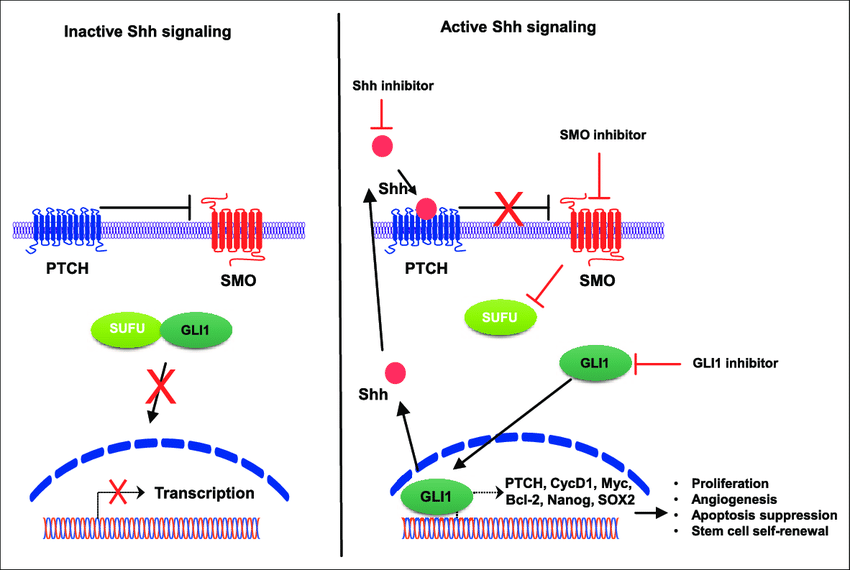A Note About Images: The images used in our articles are for illustration purposes only and may not exactly match the content. They are meant to engage readers, but the text should be relied upon for accurate information.
Welcome to the captivating realm of the Hedgehog signaling pathway, a remarkable biological process that weaves together the intricate fabric of cellular communication and development. Named after the spiky mammal due to its resemblance in early experiments on fruit fly embryos, this pathway plays a pivotal role in regulating cell growth, differentiation, and tissue patterning.
As we embark on this enlightening journey, let us delve into facts about the Hedgehog signaling pathway, unraveling its secrets and shedding light on its profound impact on both normal physiology and pathological conditions. From its discovery in the 1980s to its therapeutic implications in cancer treatment, this pathway continues to mesmerize researchers with its complexity and evolutionary significance.
The Enigmatic Discovery of the Hedgehog Signaling Pathway
The Hedgehog signaling pathway was unveiled in the early 1980s by pioneering developmental biologists studying the embryonic development of fruit flies. Mutations in the Hedgehog gene resulted in striking defects in the body segmentation of the flies, sparking further investigations into this pathway across various species, including humans.
Orchestrating Embryonic Development with Precision
At the core of embryonic development lies the Hedgehog signaling pathway, guiding the intricate formation of tissues and organs with exquisite precision. From shaping the body axis to influencing limb development and cell differentiation, this pathway plays a pivotal role in the growth and development of organisms, from insects to mammals.
A Symphony of Cell Proliferation Regulation
Central to its functions, the Hedgehog signaling pathway orchestrates the symphony of cell proliferation regulation. Ensuring cells divide and multiply harmoniously, disruptions in this pathway can disrupt the delicate balance, paving the way for abnormal cell growth and diseases, including cancer.
Navigating Signal Transduction Pathways
Signal transduction through receptors Patched and Smoothened orchestrates the intricate dance of the Hedgehog signaling pathway. When Hedgehog ligands bind to Patched, the inhibition on Smoothened is lifted, paving the way for a cascade of intracellular signaling events that dictate cellular fate and function.
Activating Gli Transcription Factors for Cellular Harmony
Upon activation, the Smoothened receptor sets in motion a series of intracellular events culminating in the activation of Gli transcription factors. These master regulators translocate to the nucleus, fine-tuning the expression of target genes essential for cell proliferation, differentiation, and tissue patterning.
Unveiling the Healing Potential in Tissue Regeneration
Beyond development, the Hedgehog signaling pathway emerges as a key player in tissue regeneration, fueling the repair and renewal of damaged tissues such as the liver and skin. Unveiling the underlying mechanisms holds promise for the development of therapeutic strategies to promote tissue regeneration in diverse conditions.
Illuminating Neural Development Pathways
Essential for neural development, the Hedgehog signaling pathway intricately guides the formation and patterning of the central nervous system, shaping the brain and spinal cord. Defects in this pathway can give rise to severe developmental disorders, underscoring its critical role in neurodevelopmental processes.
Nurturing Stem Cell Maintenance for Regenerative Purposes
In the realm of stem cell regulation, the Hedgehog signaling pathway emerges as a guardian, preserving the stem cell population and orchestrating their differentiation into specialized cell types. Vital for tissue homeostasis and repair, this pathway holds promise for regenerative medicine and future therapeutic interventions.
Illuminating Birth Defects and Therapeutic Insights
Disruptions in the Hedgehog signaling pathway have been linked to a spectrum of birth defects, ranging from craniofacial abnormalities to limb malformations and heart defects. By unraveling the genetic and molecular underpinnings of this pathway, valuable insights into the prevention and treatment of these conditions come to light.
Unveiling Therapeutic Avenues in Cancer Treatment
The Hedgehog signaling pathway emerges as a beacon of hope in the realm of cancer treatment, offering promising targets for intervention. With the development of drugs specifically targeting components of this pathway, such as in basal cell carcinoma, the potential for targeted therapies in various cancers continues to expand.
Embracing the Role of Cilia in Signaling Pathways
Cilia, the small hair-like structures adorning cells, serve as crucial players in the Hedgehog signaling pathway, acting as hubs for its components and ensuring proper regulation of signaling. Defects in cilia structure or function can disrupt Hedgehog signaling, paving the way for developmental anomalies and diseases.
Celebrating Conservation Across Species in Biological Significance
The Hedgehog signaling pathway transcends species boundaries, showcasing its profound biological significance and evolutionary conservation. From fruit flies to humans, this pathway underscores its fundamental role in development, offering invaluable insights into biological functions with far-reaching implications for human health and disease.
Conclusion: Embarking on a Journey of Discovery
As we unravel the mysteries of the Hedgehog signaling pathway, we embark on a journey of discovery into the intricate world of cellular communication and development. From its regulatory mechanisms to its signaling components, this pathway captivates researchers with its profound impact on cellular function and disease.
Dive deeper into the captivating realm of signal transduction, where molecular messages shape the very essence of life itself. Explore the wonders of developmental biology and witness the awe-inspiring process of tissue regeneration, paving the way for novel therapeutic approaches and targeted cancer therapies.
FAQs: Navigating the Hedgehog Signaling Pathway
What is the Hedgehog signaling pathway?
The Hedgehog signaling pathway is a vital cellular communication pathway regulating developmental processes and tissue homeostasis.
How does the Hedgehog signaling pathway operate?
Activation of the Hedgehog pathway occurs when the ligand Hedgehog binds to its receptors, initiating a cascade of intracellular events influencing gene expression and cell fate determination.
What are the key components of the Hedgehog signaling pathway?
The main components include the ligand (Hedgehog), receptors (Patched and Smoothened), and downstream effectors (Gli family of transcription factors).
What role does the Hedgehog pathway play in development?
Crucial for embryonic development, the pathway guides limb formation, brain development, and organogenesis, contributing to tissue regeneration and maintenance in adult organisms.
How is the Hedgehog signaling pathway linked to cancer?
Dysregulation of the pathway is associated with various cancers, with mutations or abnormal activation of its components promoting uncontrolled cell growth and tumor formation.
Are there therapeutic drugs targeting the Hedgehog pathway?
Yes, drugs targeting specific components of the pathway have shown promise in treating certain cancers where the pathway is dysregulated.
Is the Hedgehog signaling pathway conserved across species?
Absolutely, the pathway is highly conserved across diverse species, showcasing its fundamental importance in biological processes and underscoring its evolutionary significance.
The journey through the enigmatic Hedgehog signaling pathway continues to unveil new discoveries and therapeutic avenues, offering a glimpse into the intricate world of cellular communication. Join us as we unravel the mysteries of this pathway, paving the way for groundbreaking advancements in regenerative medicine and cancer therapy.






